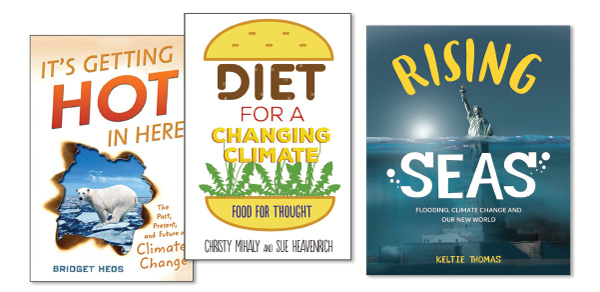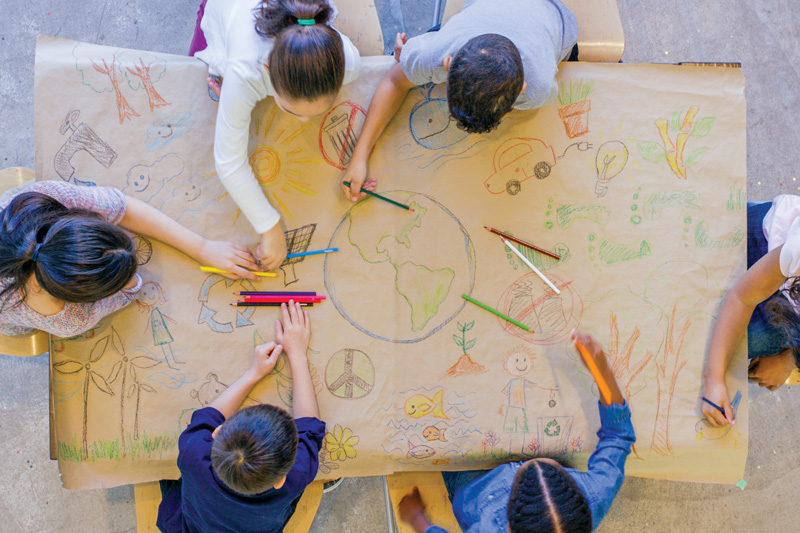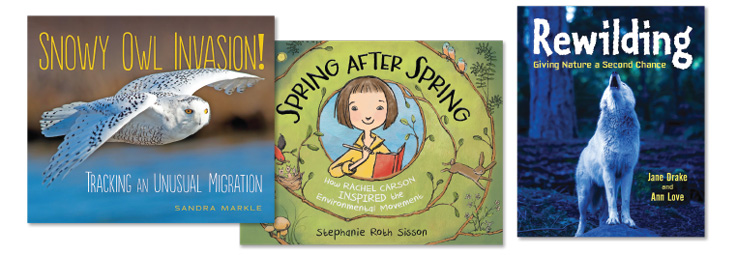Making a World of Difference: 19 Nonfiction Titles On Climate Change
When it comes to questions about climate change, it’s imperative that we urge children and teens to seek answers that enlighten, inspire, and stimulate them to get involved as responsible inhabitants of this planet.
|
|
|
Photograph by FatCamera/Getty Images |
Hurricanes, droughts, floods—the impact of climate change is real. Why is it happening, and what can we do about it? It’s imperative that we urge children and teens to seek answers that enlighten, inspire, and stimulate them to get involved as responsible inhabitants of this planet.
Titles for younger readers on this topic often take an accessible approach, focusing on the consequences of climate change on familiar animals, such as hares, butterflies, and owls. Some examine scientists and ordinary people working together to help these beloved creatures, while others detail the extraordinary contributions of individuals, such as Rachel Carson, Wangari Maathai, and Ken Nedimyer.
Older readers can expect to dig deeper into more complex problems: rising seas, the destruction of coral reefs, and the plight of climate migrants. These volumes not only define these subjects but also discuss solutions. There are also stirring stories of those making a difference, such as Scott Dowd, senior aquarist with the New England Aquarium in Boston, who is working with other scientists and local fisherman in the Amazon rain forest to develop a sustainable fishery that protects this hugely important environment.
The best books on climate change explain why it is happening, share the experiences of changemakers, and offer ways for young people to get involved.
Elementary
COLLARD, Sneed B., III.Hopping Ahead of Climate Change: Snowshoe Hares, Science, and Survival. photos by author. 64p. further reading. glossary. index. websites. Bucking Horse Bks. 2016. Tr $18. ISBN 9780984446087.
Gr 3-5–Now that spring arrives earlier and summer leaves later in the Rocky Mountains, the snowshoe hare is in trouble. Its coat, which changes color from brown to white based on the length of daylight hours, no longer matches its surroundings, making it easy prey. Many fascinating and large color photographs accompany this well-told examination of the impact of this dangerous mismatch and how scientists are studying this problem.
EAMER, Claire.Out of the Ice: How Climate Change Is Revealing the Past. illus. by Drew Shannon. 32p. charts. chron. further reading. glossary. maps. photos.Kids Can. 2018. Tr $17.99. ISBN 9781771387316.
Gr 3-6–As climate change continues to cause Earth’s air, water, and ground to warm, previously frozen spots—ice patches, glaciers, and permafrost—are melting. This development has revealed exciting finds, such as human and animal remains, artifacts, plants, dust, and more, buried deep below. A woolly mammoth, for example, was recently found in melting permafrost in Russia. Informative text, sidebars, photographs, and colorful graphite and digital illustrations combine for a timely and engaging picture book.
GREEN, Jen.50 Things You Should Know About the Environment. 80p. charts. diag. photos. Quarto. 2016. pap. $15.95. ISBN 9781682970218.
Gr 3-5–Designed for browsing, this broad overview deftly distinguishes between key ideas and pertinent details through numerous infographics. The section devoted to climate change introduces global warming, greenhouse gases, consequences, and clean energy sources.
HIRSCH, Rebecca E. The Monarchs Are Missing: A Butterfly Mystery. 56p. bibliog. further reading. glossary. index. notes. photos. websites. Millbrook. 2018. lib. ed. $31.99. ISBN 9781512452501.
Gr 3-7–A close-up look at efforts to find out why the population of monarch butterflies is decreasing. Several hypotheses are offered, including record-breaking droughts caused by climate change. Readers learn about the important role of citizen scientists who help scientists by gathering data, and steps we can all take to help monarch numbers bounce back. Excellent photos support this reader-friendly text.
KELLY, Irene.A Frog’s Life. illus. by Margherita Borin. 40p. Holiday House. 2018. Tr $17.99. ISBN 9780823426010.
K-Gr 3–The author shares a great deal of intriguing information about frogs—that there are more than 4,000 types, how they shed their skin, and more. Intricate and colorful illustrations show how frogs exist in a variety of environments. The work concludes by explaining how these amphibians are endangered due to climate change, pollution, and habitat destruction.
MARKLE, Sandra. Snowy Owl Invasion!: Tracking an Unusual Migration. 48p. further reading. glossary. index. notes. photos. websites. Millbrook. lib. ed. $31.99. ISBN 9781512431063.
Gr 4-6–Why would snowy owls usually found in the Arctic suddenly appear in large numbers in Canada and several U.S. states? Scientists set out to discover the answer. Possible reasons include competition for hunting territory, strong winds that moved the owls, and climate change. Clearly written text accompanied by large, close-up photographs invites readers to ponder this mystery.
MESSNER, Kate. The Brilliant Deep: Rebuilding the World’s Coral Reefs. illus. by Matthew Forsythe. 48p. further reading. glossary. photos. websites. Chronicle. 2018. Tr $17.99. ISBN 9781452133508.
K-Gr 3–While the world’s coral reefs are dying, owing in part to rising ocean temperatures, one man’s efforts are making a difference. Ken Nedimyer discovered how to grow colonies of coral to plant on dying reefs. This beautiful book packs a mighty message of hope for combating the effects of climate change. An illustrated glossary explains selected vocabulary.
PREVOT, Franck. Wangari Maathai: The Woman Who Planted Millions of Trees. illus. by Aurélia Fronty. 48p. bibliog. chron. maps. notes. photos. websites. Charlesbridge. 2015. Tr $17.95. ISBN 9781580896269.
Gr 1-4–When Wangari Maathai returned to her homeland of Kenya after studying abroad, she noticed the widespread cutting down of trees to plant cash crops like tea. The soil had washed away, and women could not feed their children. To prevent further environmental destruction, Wangari created tree nurseries across Kenya, and with her supporters, she planted more than 30 million trees. Substantial back matter complements a well-crafted narrative of an important figure in eco-justice.
SISSON, Stephanie Roth. Spring After Spring: How Rachel Carson Inspired the Environmental Movement. illus. by author. 40p. bibliog. diag. notes. Roaring Brook. 2018. Tr $17.99. ISBN 9781626728196.
Gr 1-3–Lyrical text and detailed illustrations explore the childhood of Rachel Carson, steeped in the beauties of nature amid the changing seasons. After college, she combined her interest in science with her passion for writing to become an author. Her book Silent Spring, which alerted readers to the toll of poisonous chemicals on nature, remains crucial to our understanding of human impact on the environment.
WANG, Andrea. How Can We Reduce Fossil Fuel Pollution? 40p. (What Can We Do About Pollution?). charts. diag. further reading. glossary. index. photos. Lerner. 2016. lib. ed. $30.65. ISBN 9781467795135.
Gr 3-5–For each type of pollution caused by burning fossil fuels—solid wastes, wastewater, and air emissions—the author answers three questions: What is it? How much is produced and how? What can we do about it? Lucid, informative text is well supported by captioned photographs and myriad suggestions for taking action.
WILLIAMS, Lily.If Polar Bears Disappeared. illus. by author. 40p. bibliog. glossary. websites. Roaring Brook. 2018. Tr $17.99. ISBN 9781250143198.
Gr 1-4–Williams raises an important question: What if climate change caused too much sea ice to melt? Initially, polar bears would die off, but other predators would step in, disrupting the balance of predators and prey. The effects would spread to more and more ecosystems. But, as the author notes, it doesn’t have to happen. Pair this persuasive call to action with Williams’s earlier title If Sharks Disappeared.

Middle to High School
BENNETT, Jeffrey.A Global Warming Primer: Answering Your Questions about the Science, the Consequences, and the Solutions. 128p. further reading. index. photos. Big Kid Science. 2016. pap. $15. ISBN 9781937548780.
Gr 9 Up–With awe-inspiring clarity and solid research, the author presents current information about global warming. He argues that basic science supports the claim that climate change is real, refutes skeptics’ assertions, and posits that there are several solutions to seriously consider. This is an extraordinary example of perceptive thinking that encourages readers to weigh the evidence for themselves.
DRAKE, Jane & Ann Love.Rewilding: Giving Nature a Second Chance. 88p. bibliog. further reading. glossary. index. photos. Annick. 2017. Tr $19.95. ISBN 9781554519620; pap. $12.95. ISBN 9781554519613.
Gr 4-7–The process of biologists and concerned citizens working together to restore habitats and reintroduce species that once lived there is called “rewilding.” If, for example, scientists bring back herds of woolly mammoths, they might be able to restore the tundra, protect the permafrost beneath from melting, and reduce global warming. Readers are challenged to think about the possible benefits and risks involved in rewilding projects.
HEOS, Bridget.It’s Getting Hot in Here: The Past, Present, and Future of Climate Change. 240p. bibliog. charts. further reading. glossary. index. notes. photos. websites. HMH. 2015. Tr $17.99. ISBN 9780544303478.
Gr 6-9–After an introduction to the science behind this global event, Heos deals with the politics involved: Why are people skeptical about climate change? How are we causing it? What can we do about it? The author describes the historical background, current situation, and what might lie ahead if we make sound decisions.
HIRSCH, Rebecca E.Climate Migrants: On the Move in a Warming World. 88p. bibliog. further reading. glossary. index. notes. photos. websites. Twenty-First Century. 2017. lib. ed. $35.99. 9781467793414.
Gr 9 Up–This book focuses on the impact of rising tides, which are affecting island nations; reoccurring droughts, which are affecting the Sahel region of Northern Africa; and coastal hurricanes, impacting U.S. coastal cities and states. This clear-eyed work emphasizes the personal consequences of climate change, predictions for the future, and recommendations for preventing a global crisis.
MIHALY, Christy & Sue Heavenrich.Diet for a Changing Climate: Food for Thought. 128p. bibliog. diag. further reading. glossary. index. photos. websites. Twenty-First Century. 2018. lib. ed. $37.32. ISBN 9781512481211.
Gr 9 Up–A diet of weeds, invasive plants like kudzu, and insects such as crickets, beetles, and spiders are not only nutritious and high in vitamins but also require less food, water, and land to produce than raising chickens, cows, or pigs. Mihaly and Heavenrich make a convincing argument for combating climate change by altering what we eat.
MONTGOMERY, Sy.Amazon Adventure: How Tiny Fish Are Saving the World’s Largest Rainforest. photos by Keith Ellenbogen. 80p. (Scientists in the Field). bibliog. index. photos. HMH. 2017. Tr $18.99. ISBN 9780544352995.
Gr 5-8–Saving the Amazon rain forest is essential since its trees provide a fifth of the world’s oxygen. This is the inspiring story of how local fishermen along the Río Negro collect beautiful tiny fish for the international aquarium trade, earning their living in an environmentally sustainable way. Working with scientists to improve their practices, these fishermen are also helping to protect the rain forest and slow global climate change.
THOMAS, Keltie.Rising Seas: Flooding, Climate Change and Our New World. illus. by Belle Wuthrich & Kath Boake W. 64p. diag. further reading. glossary. index. maps. photos. websites. Firefly. 2018. Tr $19.95. ISBN 9780228100225; pap. $9.95. ISBN 9780228100218.
Gr 4-8–A brief explanation of why sea levels are rising, how fast they are rising, and a map depicting “watery hotspots” is followed by an examination of sea level rise around the world. Photo illustrations present what each place might look like as the sea rises and what it looks like now. This is an eye-opening glimpse at the worldwide impact of rising temperatures.
WICKS, Maris.Coral Reefs: Cities of the Ocean. illus. by author. 128p. (Science Comics). bibliog. further reading. glossary. websites. First Second. 2016. Tr $19.99. ISBN 9781626721463; pap. $12.99. ISBN 9781626721456.
Gr 4-6–With a good dose of humor, lots of information, and an appealing graphic novel format, this book clearly explains the characteristics of coral reefs, how they are formed, and their connection to the rest of the planet. A final chapter explores how climate change affects coral reefs through coral bleaching and ocean acidification, and recommends actions we can take to protect these fragile ecosystems.
Digital PicksClimate Kids: NASA’s Eyes On the Earth. Gr 3 Up –This child-friendly site answers big questions related to climate change, features people involved in "green careers," and provides games, activities, and videos. Gr 3 Up –Find out more about coral restoration projects that extend the mission of Ken Nedimyer, whose work is highlighted in Kate Messner’s The Brilliant Deep: Rebuilding the World’s Coral Reefs. National Park Service: Climate Change. Gr 3 Up –Photos and videos demonstrate the effects of sea level rise, glacial change, and ocean acidification on our national parks. Also shows how scientists and citizen-scientists are confronting these problems. Gr 5-8 –Videos and text describe the work of fishermen in the Amazon rain forest who are engaging in sustainable practices that protect the environment and support local people. This project is described in Sy Montgomery’s Amazon Adventure: How Tiny Fish Are Saving the World’s Largest Rainforest. The South Tyrol Museum of Archaeology. Gr 3-7 –Information about Ötzi the Iceman, a man who lived more than 5,000 years ago and whose remains were discovered by two German hikers buried in glacial ice. Ötzi is discussed in Claire Eamer’s Out of the Ice: How Climate Change Is Revealing the Past. U.S. Global Change Research Program. Gr 3-7 –Provides information about climate change—what’s happening and why, impact on society, and response options. |
Myra Zarnowski is a professor in the department of Elementary and Early Childhood Education at Queens College, NY.
RELATED
The job outlook in 2030: Librarians will be in demand
The job outlook in 2030: Librarians will be in demand
ALREADY A SUBSCRIBER? LOG IN
We are currently offering this content for free. Sign up now to activate your personal profile, where you can save articles for future viewing








Add Comment :-
Be the first reader to comment.
Comment Policy:
Comment should not be empty !!!